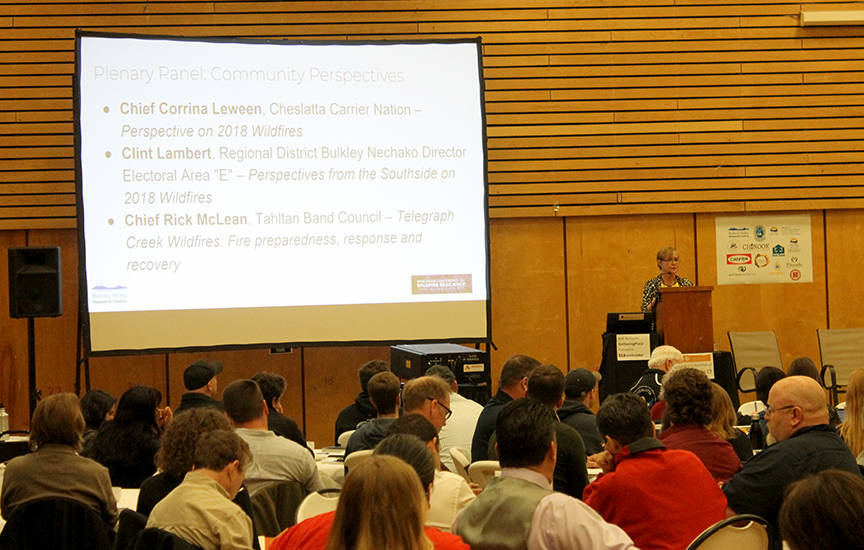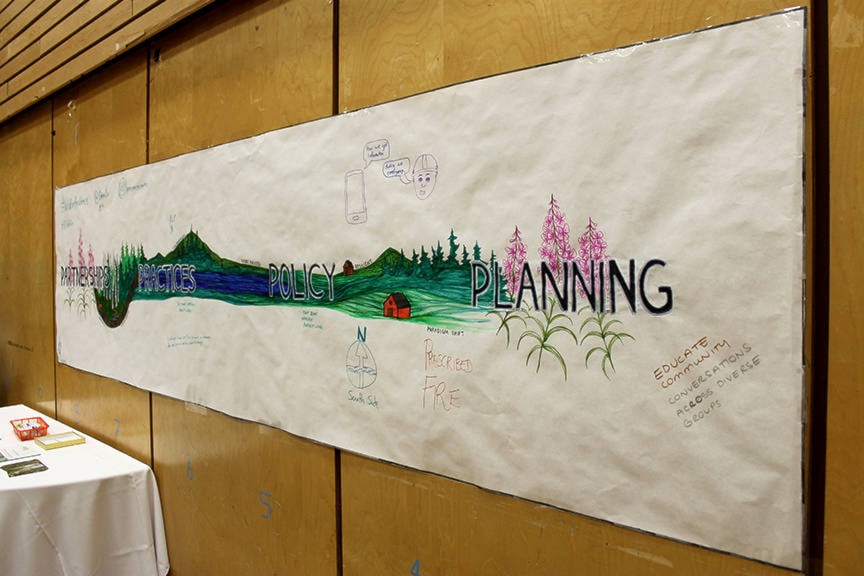Innovative ideas in forest management and empowering local communities in the face of wildfire threats were the key takeaways of the Northern Conference for Wildfire Resiliency held April 24-26 in Burns Lake.
The event, held in the Gathering Place in Burns Lake featured more than two dozen speakers from academia, First Nations, the forestry industry and government, some of whom came from as far away as Washington state and Alberta.
More than 120 people attended the conference, organized by the Bulkley Valley Research Centre.
A common theme expressed by many of the speakers at the three-day event was that the factors behind the fires of 2018 have been known to environmental and forestry insiders for many years.
But the conference revealed that the will on act on that knowledge is a lot stronger than it was before.
“We’re trying to look at the future,” Cheslatta Carrier Nation chief Corrina Leween told the audience.
“We conferenced with the premier on policy changes to allow local residents to assume some of the ability to battle fires,” she said, explaining that the First Nation has been negotiating with a company to try and set up locally-based strike teams on the Southside so they can quickly respond to fires.
“We’re going to open our learning centre to provide the training that people will need to be able to fight wildfires and that includes all the staff of the Cheslatta Carrier Nation and the neighbouring communities.”
The community-level preparedness Leween envisions includes a campaign of making inventories of community members’ equipment and infrastructure that could be deployed on short notice in fire emergencies.
Shane Berg, Deputy Chief Forester for Ministry of Forests, Lands, Natural Resource Operations and Rural Development (FLNRORD) told the conference that resilience is about finding ways of doing things differently.
“Climate change is definitely a disruptor of forest change,” he said. “We’re working towards incorporating climate change into decision-making” since current policies don’t yet explicitly address forestry management responses to climate change.
Berg summed up an approach to confronting climate change with the phrase “waste less, use more” by trying to do less prescribed burning of forest fuel and using more of the material.
“Better utilization of the forest residue will absolutely reduce greenhouse gas emissions,” he said.
There should be more policy incentives to encourage greater use of fibre and move away from conventional forest products towards innovative products like cross-laminated timber, nano crystals, biofuels and bioplastics, he added.
Policy flexibility was also touched on by Brent May, District Manager of the Nadina Forest District with FLNRORD.
May pointed to constraints on landscape planning, specifically Visual Quality Objectives (VQOs) and Old Growth Management Areas (OGMAs) that prohibit harvesting.
Some areas with VQO or OGMA status have too much fuel on the ground as a result of mountain pine beetle infestations. But since logging activity isn’t allowed there the fuel presents wildfire risks, for example in some areas on the south side of Burns Lake.
Those constraints have been raised by communities in the region - such as the Burns Lake and Chinook community forests, and Cheslatta Carrier Nation - who have been writing up their own wildfire protection plans.
“I don’t want a fire to endanger anybody, people, communities [or] buildings,” May said. “For the people who have put in time and effort into building these wildfire protection plans…I’ll remove the constraints to allow it to happen. I’m not going to have an OGMA, VQO, connectivity corridors, any of that stuff interfere with protecting people and communities. We’ll amend them if they’re in the way.”
The cautionary message that forestry consultant Bruce Blackwell had for the conference showed why policy innovation and flexibility are necessary amid worsening wildfires.
“The firestorm came in 2017 and 2018 and I don’t think it’s finished. I think there’s a lot more to come,” said the principal of B.A. Blackwell and Associates.
Presenting power point data of weather patterns in Burns Lake, Blackwell explained that the trend of hot days with heightened fire risk has been increasing over the last few years.
Since 2017, large landscape fires burning up high amounts of fuel occurred in beetle-killed pine forests, a combination that produces catastrophic fires.
“I said this in 2011…We need to act on this or we are going to see more of these kinds of fires in the next 10 years,” he said.
Blackwell echoed the familiar warning that the fuel needs to be cleaned up, but he also proposed building fuel breaks, and showed examples on maps of 300-metre wide breaks he has written into forestry plans for the Cariboo and Rocky Mountain districts.
“Shaded fuel breaks that retain moisture and decrease wind effects. Where there is living trees we would like to see those maintained as shaded fuel breaks but where there is dead trees…we need to do removals.”
The consultant also outlined how the forest management system in British Columbia has made forests vulnerable to disturbances like insects and tree diseases, which have then been exacerbated by current climate conditions.
It’s time to rethink how the system works, he said.
“How do we incorporate disturbance properly? How do we allow disturbance to occur and not impact what we perceive to be our important values?”
Environmental consultant Dr. Karen Price highlighted how a shift in values is needed to build resilience in the face of wildfire seasons of unprecedented severity in northern B.C.
The traditional perspective of industrial forestry, she explained, “with its emphasis on what to take rather than on what to leave has compounded problems and increased the risk to biodiversity and ecological integrity. Its simplified structure…perpetuates low ecological resilience and hampers recovery from disturbances that are going to continue, whether it’s wildfire, beetles or disease.”
The solution, in her view is to move towards collaborative ecosystem restoration which takes into consideration all the values of the land including fish, moose, non-timber forest products, berries, medicinal plants and indicator species.
As an example of that approach in action, she cited an ongoing prototype project in the region of the Shovel Lake wildfire that brought together local Carrier Sekani First Nations, the provincial government and environmental initiatives.
Price acknowledged the conflicts that come up with such an approach.
“The problem here is we’ve got a conflict between short-term jobs and economy and long-term resilience and First Nation rights. Difficult one to fix,” she said. “We need help to address these conflicting goals. We have to collaborate and come together in partnerships that provide a foundation for innovation on resilience.”
Blair McBride
Multimedia reporter
Send Blair an email
Like Lakes District News on Facebook

